
Coca is any of the four cultivated plants in the family Erythroxylaceae, native to western South America. Coca is known worldwide for its psychoactive alkaloid, cocaine.

The radish is a flowering plant in the mustard family, Brassicaceae. Its large taproot is commonly used as a root vegetable, although the entire plant is edible and its leaves are sometimes used as a leaf vegetable. Originally domesticated in Asia prior to Roman times, radishes are now grown and consumed throughout the world. The radish is sometimes considered to form a species complex with the wild radish, and instead given the trinomial name Raphanus raphanistrum subsp. sativus.

Liquorice or licorice is the common name of Glycyrrhiza glabra, a flowering plant of the bean family Fabaceae, from the root of which a sweet, aromatic flavouring is extracted.
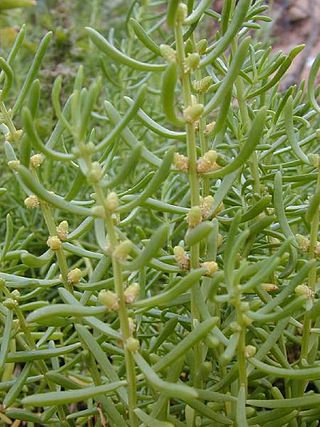
Batis is a genus of two species of flowering plants, the only genus in the family Bataceae. They are halophytic plants, native to the coastal salt marshes of warm temperate and tropical America and tropical Australasia.

Pierre Edmond Boissier was a Swiss prominent botanist, explorer and mathematician. He was the son of Jacques Boissier (1784-1857) and Caroline Butini (1786-1836), daughter of Pierre Butini (1759-1838) a well-known physician and naturalist from Geneva. With his sister, Valérie Boissier (1813-1894), he received a strict education with lessons delivered in Italian and Latin. Edmond's interest in natural history stemmed from holidays in the company of his mother and his grandfather, Pierre Butini at Valeyres-sous-Rances. His hikes in the Jura and the Alps laid the foundation of his zest for later exploration and adventure. He attended a course at the Academy of Geneva given by Augustin Pyramus de Candolle.
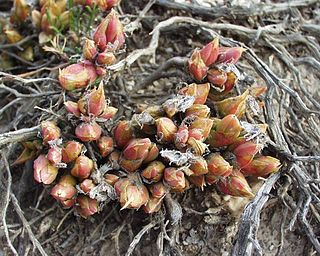
Mesembryanthemum tortuosum is a succulent plant in the family Aizoaceae native to the Cape Provinces of South Africa. It is known as kanna, channa, kougoed —which literally means, 'chew(able) things' or 'something to chew'.
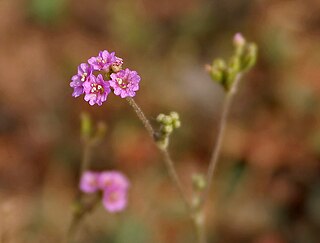
Boerhavia is a genus of over 100 species in the Nyctaginaceae family. The genus was named for Herman Boerhaave, a Dutch botanist, and the genus name is frequently misspelled "Boerhaavia". Common names include spiderlings and hogweeds.
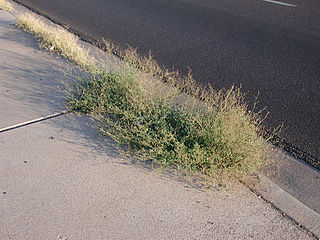
Boerhavia intermedia is a species of spiderling plant known by the common name five-wing spiderling. It is sometimes considered a subspecies of the common weed Boerhavia erecta. This spiderling is a fairly widespread annual herb of the southwestern United States and northern Mexico. It is somewhat variable in appearance, but in general it is loosely clumping, raising erect stems up to half a metre in height. It has lance-shaped, wavy-margined leaves and bears a branching inflorescence of clustered or singular flowers, each pale pink flower only one or two millimetres across. The clustered fruits that appear afterwards are tiny club-shaped, ridged achenes less than 3 mm long. This is a hardy plant, growing in arid, rocky, or disturbed areas, and often showing up as a roadside weed.

Boerhavia coccinea is a species of flowering plant in the four o'clock family which is known by many common names, including tar vinescarlet spiderling and red boerhavia.
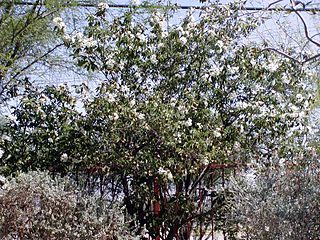
Cordia boissieri is a white-flowered, evergreen shrub or small tree in the borage family (Boraginaceae). Its native range extends from southern Texas in the United States south to central Mexico. Common names include anacahuita, Mexican olive, white cordia, and Texas wild olive. It is named after the Swiss explorer and botanist Pierre Edmond Boissier.
Ulmus boissieriGrudz.,, a disputed species of elm found in Iran, was identified by Grudzinskaya in 1977. She equated her "new species" with the U. campestris f. microphylla collected in 1859 in Kerman Province and described in his Flora Orientalis (1879) by Boissier, for whom she named it, treating Boissier's specimen as the "type". The tree is endemic the provinces of Kermanshah and Kerman., and also the Zagros forests, growing with Quercus brantii, Celtis australis, Platanus orientalis, Fraxinus sp., and Cerasus mahaleb.

Boerhavia diffusa is a species of flowering plant in the four o'clock family which is commonly known as punarnava, red spiderling, spreading hogweed, or tarvine. It is taken in herbal medicine for pain relief and other uses. The leaves of Boerhavia diffusa are often used as a green vegetable in many parts of India.

Herbs are a widely distributed and widespread group of plants, excluding vegetables and other plants consumed for macronutrients, with savory or aromatic properties that are used for flavoring and garnishing food, for medicinal purposes, or for fragrances. Culinary use typically distinguishes herbs from spices. Herbs generally refers to the leafy green or flowering parts of a plant, while spices are usually dried and produced from other parts of the plant, including seeds, bark, roots and fruits.

Boerhavia dominii, commonly known as tarvine, is a species of flowering plant in the four o'clock family. It is native to Australia.

Boerhavia erecta, commonly known as the erect spiderling or the erect boerhavia, is one of more than 100 species in the genus Boerhavia L. Boerhavia erecta is native to the United States, Mexico, Central America, Angola and western South America, but now is cosmopolitan in tropical and subtropical regions. In Africa its distribution extends from West Africa, eastwards to Somalia and down to South Africa. It has recently been found in parts of Madagascar and Réunion. In Asia, it occurs in India, Java, Malaysia, the Philippines, China and the Ryukyu Islands.

Senega officinalis is a species of flowering plant in the milkwort family, Polygalaceae. It is native to North America, where it is found in southern Canada and the central and eastern United States. Its common names include Seneca snakeroot, senega snakeroot, senegaroot, rattlesnake root, and mountain flax. Its genus name honors the Seneca people, a Native American group who used the plant to treat snakebite.

Iris boissieri, is a species in the genus Iris, it is also in the subgenus Xiphium. It is from Europe, mainly Spain and Portugal. It has blue-purple flowers with a yellow beard.

Commicarpus is a genus of flowering plants belonging to the family Nyctaginaceae. The genus contain some 30 to 35 species which are native to the tropics and subtropics. Most are found in Africa and western Asia, and eight species are native to southern Africa.

Phenacoccus solenopsis, the cotton mealybug or solenopsis mealybug, is a species of mealybug in the family Pseudococcidae. Having originated in North America, it has spread to other parts of the world and become a major pest of cotton crops.

















